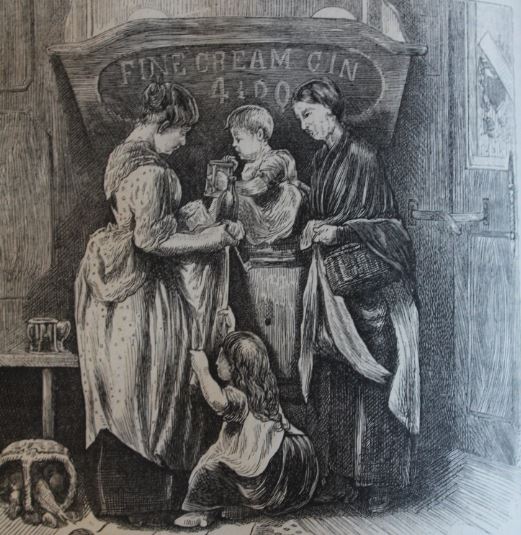
‘Gin Parlour’ by the Religious Tract Society 1854 artist not credited
Ann Livingston was one of the many colourful characters of early Hobart and New Norfolk. As an ancestor she is a fascinating subject for research. She was probably quite difficult to be around, but her indomitable spirit comes through very clearly.
Her earliest days are still shrouded in mystery. Most likely, Ann herself had no idea of her precise birthplace or birth year. The event occurred around 1809 in Renfrewshire in Scotland, maybe somewhere near Paisley since this is where we first find her.
The town of Paisley is an easy twelve miles from Glasgow. In 1810 it was called a town. One 1823 edition of the Encylclopaedia Britannica says ‘The whole population of Renfrewshire amounted to 78,000 in 1801, of which Paisley alone contained much more than a third, and in 1811 it was 92,596.” It was a region of growing population and shrinking industry.
At the turn of the 19th century the main industries of Paisley were agriculture, cotton and minerals. Many of the local families contained sailors and fishermen. We can glean some idea of life there from books and newspapers of the time which might help to identify Ann’s early experiences. The region was assessed in 1811 for the British government by one John Wilson, and his report was published a year later. In his chapter on new infrastructure, Wilson describes the region’s canal development as follows:
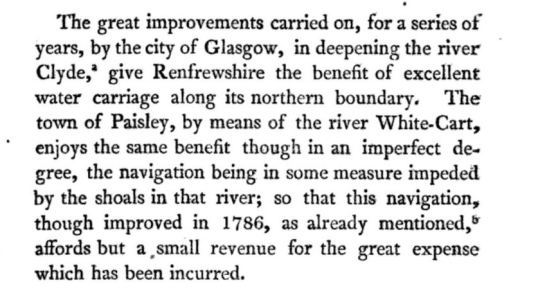
General View of the Agriculture of Renfrewshire 1812, drawn up for the consideration of the Great Britain Board of Agriculture by John Wilson
John Wilson undertook his contracted duty with diligence and attention to detail, but clearly his instructions were to identify and assess the county’s wealth and future financial prospects. Knowing the future of Scotland and its smallholders, we can see the beginnings of their end in reports such as this. After noting the ruined castles which dotted the region, his assessment is quite pessimistic.
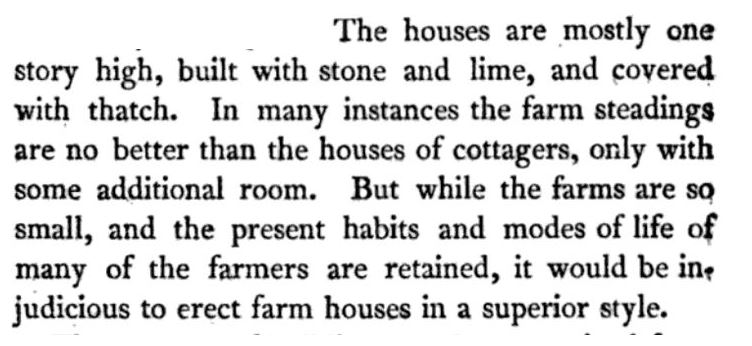
General View of the Agriculture of Renfrewshire 1812, drawn up for the consideration of the Great Britain Board of Agriculture by John Wilson p61
So just what does John Wilson mean by this? Basically that the farmers are of too low a class to be worth better housing. In another few pages he begins to explain:

Finally, we have a description of the poor people of the region.
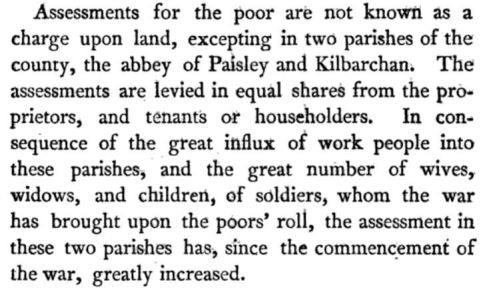
Wilson page 80
It’s a very impersonal and clinical description but we can begin to see the situation. There were itinerant workers and families without support. The farmers were barely hanging on to their homes, the canal had failed to provide egress for trade and there was very little in place to support poor people.
Ann has a local surname. There were Livingstons scattered right across this region but they don’t seem to fit into a coherent family. The Napoleonic wars had taken many men, put an end to a lot of trade. Somewhere, Ann had a biological father and mother, but perhaps her father was a soldier and not present in her life? Perhaps her mother was one of the semi-nomadic seasonal workers referenced above who became pregnant to a local man? Until a baptism record is found we have no idea at all.
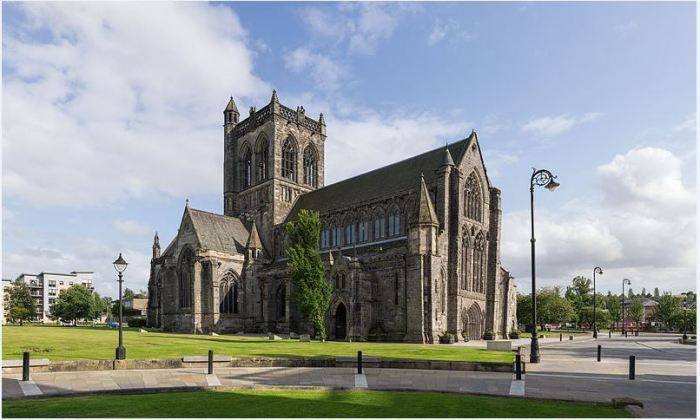
Paisley Abbey from North West © User:Colin / Wikimedia Commons / CC-BY-SA-3.0 (creativecommons dot org/licenses/by-sa/3.0/)
After this very emotionless description, we can examine newspaper reports for more detail. The following excerpts are a small sample involving events around Paisley but they show the situation clearly – people surviving any way they can, children left alone while the parents are working, regiments coming and going and the need to constantly watch out for fraud in every transaction. This was the world for Ann Livingston as she grew from baby years into comprehending childhood.
1807: Alexander Taylor, [surgeon’s apprentice] and Matthew Smith, gardener, both of Paisley, were accused of the murder of an infant child. The indictment accused Smith of having taken from Agnes Kelly, on the street of Paisley, a female child of between two and three months old ... (Scots Magazine 01 Feb 1807)
From the Caledonian Mercury 20 Feb 1812)
A number of disorderly women and vendors of base coin have been taken into custody, and sentenced to solitary confinement in the Bridewell (Glasgow).
Tuesday this week, the Berwickshire Regiment of Militia marched from Queensberry-House Barracks for Paisley.
A female swindler, of decent appearance, upon Friday last came to lodge in a house in Leith St. She pretended she had come on the coach from Falkirk and that her husband was an officer in the navy whom she expected to arrive hourly by the road. On Tuesday afternoon the lady decamped, taking with her a large number of valuable items from the house.
1812 (all from the Caledonian Mercury 16 Nov 1812):
John Cochran, carter, was tried for cutting away the land-fasts of a vessel moored at the Broomielaw, and selling them for old rope ….
James Crawford, a deaf and dumb man, was attacked between Glasgow and Paisley by three foot-pads, cut and abused very much, and robbed of a silver watch ….
A man in Paisley was robbed of ninepence and a pair of new shoes, which the villains took off his feet after cruelly abusing him ….
Two children in separate towns, both very young, were burned to death this week in singularly similar circumstances. In each case the fathers were absent on business and the mothers had gone out to raise potatoes ….
(from the Caledonian Mercury 06 Apr 1814)
On Wednesday last, a Paisley gentleman left Glasgow betwixt nine and ten o’clock to walk home. On the way, three men sprung out from the Plantation west gate, one of whom grappled the gentleman by the collar and attempted to trip him; while the other two struck him with sticks over the head and brought him to the ground. While in this situation two of them proceeded to rifle his pockets while the third held a pistol within a few inches of his face. Not one of them during the whole transaction ever uttered a word ….
And then, seemingly a long way off in Manchester, England, came an event now known as the Peterloo Massacre.
Wikipedia (2016) describes it this way:
The Peterloo Massacre occurred at St Peter’s Field, Manchester, England, on 16 August 1819, when cavalry charged into a crowd of 60,000–80,000 that had gathered to demand the reform of parliamentary representation.
At the time of the Peterloo Massacre, Ann Livingston was about ten years old. The event sent shockwaves across Great Britain. Men and women from all walks of life united in protest. News travelled and protesters mobilized.

Paisley, Renfrewshire, Scotland By Sarah Q from Northern, NJ, United States (Flickr) [CC BY-SA 2.0 (http://creativecommons.org/licenses/by-sa/2.0)], via Wikimedia Commons
In the course of last week a bill, with a mourning border, calling a meeting for Saturday of the inhabitants of Paisley and its vicinity to take into consideration the late proceedings at Manchester, was circulated in the above district. But when the hour of meeting came, three o’clock in the afternoon, it was found necessary owing to the inclemency of the weather to postpone, for the rain fell in torrents. The Meeting stands postponed until Saturday.
The Public Ledger of 17 September 1819 tells us a little more (much abbreviated):
The postponed meeting .. took place on Saturday last .. about two miles southwest of Paisley. The day was fine and the numbers assembled was great, perhaps from 10,000 to 12,000. All the speakers were dressed in mourning .. numerous speakers .. angry tirades on the character and conduct of the Manchester magistrates ..
In consequence of what is not known, but all the town hall windows were broken and the mob had not dispersed at half past 11. The Sheriff and the constables were grossly insulted, and assailed with stones while parading the streets. A considerable number of rioters were taken into custody.
The following day was reported as follows also by the Public Ledger:
On Sunday the scene of riot and outrage was renewed in Paisley. During the day a number of persons assembled in the streets. By seven o’clock their numbers had greatly increased and they proceeded to open violence. The Sheriff Deputy was knocked down, kicked and left insensible. Many other respectable individuals were assaulted and abused, and their houses damaged. It was found necessary to read the Riot Act and call out the military. The constables with patrols of soldiers searched the streets and the town is again tranquil.
This blog is not about the Paisley Riots but since our Ann was in the middle of this event, it undoubtedly had a huge impact on her. One letter writer of the time described the town as for the whole of that Sunday having a ‘very threatening aspect’. By that Sunday night there were rumours of large crowds marching out from Glasgow to join the fray. Very few residents would have slept well that night.
The Yorkshire Gazette of 25 September 1819 gives the end of the story.
At Glasgow, a number of villains who had collected in the Green, with a view to joining the rioters in Paisley, returned to Glasgow after having been, three miles out of the town, joined at the New Bridge by a crowd of about 8,000, who paraded the streets for some time. It being represented to the magistrates that a riot would take place .. two troops were fetched from Hamilton. About nine o’clock the riot act was read and the cavalry called out. About 100 persons were arrested and sent to the Police Office.
The unrest went on for days, involving vandalism of anything made of glass, stone throwing and attacks with sticks. Shops stayed closed for a week. Eventually it settled down, with the jails completely full and the military still out on full alert.
Flare-ups continued for months and nothing improved for those without money. The newspapers are full of robberies, murders and abandoned babies. We have no idea what was happening to Ann in these years but given her personality later on, she was probably learning by now to watch out for herself. These were undoubtedly tough and lonely years.
According to Ann’s later statement, her first stint in Paisley Jail was for one fortnight when she was aged about twelve years. Her second was for eight months in the same place for housebreaking. Hopefully a record will show up one day for these periods of incarceration. After her release from jail the second time, she was aged about thirteen, maybe fourteen.
At the time of her third arrest in early 1824 at the age of fourteen, her occupation is recorded as ‘prostitute’. Ann and 18 year old Alexander Stevenson, also of Paisley, were caught ‘opening lock-fast places’ in Glasgow. They were placed in Glasgow prison to await trial at the April sessions.
Leave a Reply